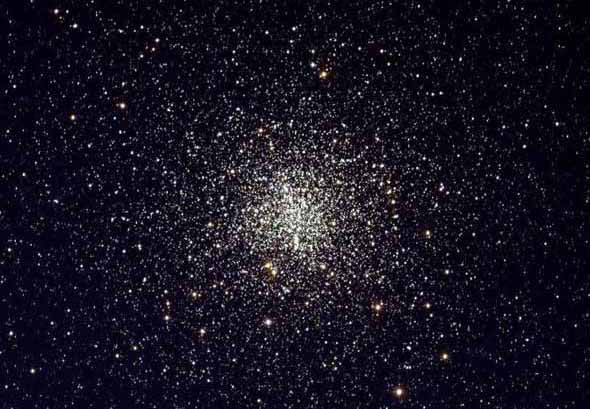Milky Way
Globular
Clusters
Index
1. Introduction
2. Orbits
3. Omega Centauri
4. 47 Tucanae
5. 47 Tuc Core
6. 47 Tuc Blue Stragglers
7. M4
8. M5
9. M10
10. M13
11. M15
12. M22
13. NGC 6522
14. Galactic Centre Chart
15. List of MW Globulars
16. Credits and Links
M4

Image credit: NOAO/AURA/NSF
Messier 4 or NGC 6121 is a globular cluster in the constellation Scorpius. It is just visible to the naked eye (visual magnitude of 5.6). Through binoculars or a small telescopes it is a fuzzy ball of light about the size of the full Moon. It is one of the easiest globular clusters to find, lying only 1.3° west of the bright star Antares - both objects are visible in a wide field. A modest sized telescopes resolves individual stars - the brightest in M4 are apparent magnitude 10.8. At 7,200 light-years, M4 is perhaps the closest globular cluster to us. It contains hundreds of thousands of stars. The light that reaches us from them is severely dimmed by intervening molecular clouds. M4 is about 75 light years across.
Perhaps because of its closeness, it is one of the more intensely studied globular clusters. In 1768, Charles Messier resolved this fuzzy ball of light into its constituent stars - it thus became the first globular to be characterised as a star cluster. The white dwarfs in M4 have been surveyed by the Hubble Space Telescope. From temperature measurements of these spent stellar cores, the survey team obtained an independent estimate of the age of the cluster (and the universe): 13 billion years. One of M4's white dwarfs is a binary star with a millisecond pulsar companion, PSR B1620-26. Orbiting the pulsar is a planet with a mass of 2.5 times that of Jupiter, the first exoplanet to be discovered and the oldest planet so far discovered..
Sources:
Messier 4 - Wikipedia,
Messier 4 - SEDS,
Pulsars in globular clusters, National Astronomy And Ionosphere Center,
Hubble Site, (links in text)